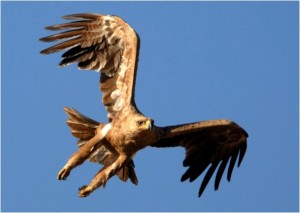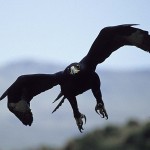Poisoning of Raptors in Ethiopia by Lakew Berhanu

Ethiopia is known for its endemism both fauna and flora. Among others, raptors are an important part of our biodiversity: Culturally, economically as well as socially. Recent research conducted informs us that vulture populations in Africa are on the decline and may be on the verge of collapse in the next half century unless we make efforts to save them. Like many other biodiversity resources, they [raptors] are under increasing threat from poisoning, habitat fragmentation, habitat loss, lack of food, poachers and careless farmers.
Globally, the death through poisoning of raptors/vultures, is increasingly becoming cause for alarm. Like many other countries, Ethiopia is known for harboring a variety of raptor species both migratory and non-migratory. Ethiopia may also have the largest population of Bearded Vultures in the world, although this needs to be verified. It is also one of the few countries on the African continent known to have a resident and breeding population of Golden Eagles.
However, not much is done in terms of biodiversity research, particularly on their threats like poisoning of raptors in the country. In Ethiopia, there is no such a culture to directly poison birds unless indirectly. Since recently, there are reports coming from the rural area of this country, specially from Negelle area [ Ato Mengistu Wondafrash CEO of EWNHS Pers. Communication] at least in a couple of incidences there were a number of vultures including White-backed, Rüppell’s’ and Egyptian vultures found dead due to a poison [which is not yet known]put to kill a hyena. Similarly there are unconfirmed reports where the majority of the human population is living that the continual use of (as yet unknown) pesticides is decimating some of the raptors like Augur Buzzard and Tawny Eagle. This is even clearly being mentioned and capitalized by the local farmers that they haven’t seen some birds [raptors] for a long time since they started application of these agricultural inputs to protect their farm from vermin animals including rodents. It is believed that the farmers are applying pesticides every year in order to eradicate or kill those rodents which are feeding on the farmers’ crops. Probably, the farmers are using this pesticide by spreading all over on the ground that they thought is a hiding place for the rodents and or to those areas that is affected by the rodents. Similarly, the cattle keepers might be using this unknown poisoning to kill the hyenas which are considered as one of the species always being mentioned in the human-wildlife conflict issues.

One can be sure that such approaches may not be a sustainable solution in the long-term in this inter-woven world since this will have only a short-term and limited impact to address the issue. Unfortunately, these raptors are preying on the dead rodents, which are poisoned and are becoming victims of this vicious circle. Here the natural prey-predator relationship is disrupted and thereby the whole ecosystem will be endangered in the long-term.
For the moment, it seems that very few individuals are concerned about this poisoning issue. There needs to be an urgent action to begin with. In this regard the immediate thing that comes to once mind is to work together with the agricultural extension workers who are advising the farmers on how to use such nasty chemicals to kill rodents. The agricultural extension agents are found in all rural villages. Similarly, it is important to work together with the concerned agricultural offices [at all levels], particularly at local levels, farmers themselves and other stakeholders. The awareness can be done through workshops [sensitization], production of published materials, T-shirts, caps and the like. Teachers and students [by distributing pen, pencil and the like] in the rural areas can be considered as a good entry point as well to address this issue within a short period of time. Similarly, it would be necessary to identify the type of pesticides being used and find an alternative approach. Moreover, it is important to educate the public, especially farmers and agricultural extension workers that such approach will not be sustainable and economical as well, which means that the approach only helps to address or kill the rodents for a while but will not eliminate for all. However, such poisoning approach will disrupt the natural/biological [which was done without a penny] control of rodents by removing the predators from the equation.
By the same token, it is important to identify properly those areas where this poisoning is being taking place, when, how, who and the type of poison being used and the species of birds that are being affected in the process needs to be thoroughly investigated.
Lakew Berhanu
National Project Coordinator
Sustainable Development of the Protected Area System of Ethiopia Project, EWCA
P. O. Box 122 440 Addis Ababa, Ethiopia





Lakew
What you wrote must be the first step in raising awareness for this Pan African problem of poisoning. I do hope EWCA acknowledges the problem, which I witnessed with you near Muga in 2001. Of special note is the importance of Ethiopia for migrants. It has the potential to seriously impact global populations of Eurasian raptors.
Good luck and keep at it.
Simon
Dear Lakew,
As mentioned above, it is a step forward towards unveiling the existing situation and increasing awareness among the generalpublic. In this regard, we need to imagine that such sad events are getting worse over time due to the ever-increasing human-larger carnivores conflict and thus conflict resolution mechanisms have to be devised along with the started endeavors.
Thanks,
Kahsay G.
Dear Lakew! I would like to appreciate you being concerned about the neglected issue. None, if there are, very few people consider birds as wildlife that need care and attention as that of big mammals. However, Ethiopia, as a country of many endemic birds and destination of migratory birds should have much attention. I hope you may be the one that can bring the problem to the attention of policy makers and the international community so that sustainable solution will be in place. I wish you good luck.
Dear Lakew,
This is very important information and I guess we all need to work together to change the sad story to something good. In my openion the farmers are getting this chemical from market, they donot produce it. Who are the importers? Can we bring them on board and tell them the story? I think it is possible. In short, we should also consider the private sector|s involvement in such attempt to overcome the problem, inaddition to what have been said above.
Best Regards,
Great article Lakew. In fact, Michael Fae has been mentioning this in his lectures for some time and I put up a posting about it as well on the birdlist forum: http://www.birdlist.org/phpbb/viewtopic.php?t=10
Michael Fae found out that in the Central African Republic the pesticide was good old DDT distributed to the people for spraying their houses against malaria. In such case, the pesticide may be financed and distributed by UNICEF!
In fact it may not be all that difficult to trace which pesticides may be used, as in many countries records are being kept on imports.
A visit to the Ministry of Economical Affairs, or to the whichever ministry is in charge of customs and import registration may provide you with potential culprits and their importers.
From there you may coordinate a programme for more responsible application of the pesticides.
See you in September.
Best,
Daan Vreugdenhil, PhD
Is there anybody who’s paying these act to be done intentionally. Poisoning is the act of intentional evilness. There must be a reason for it. why ? and who’s is behind it.
And Thank you for you great concern.
Dear All,
Thank you very much for your encouraging feed backs. Lets join hands to address such and other similar conservation issues.
Dear Lakew,
Here is whats poisoning them! The most likely agent…
I have been trying to find a source to voice this same concern since running into a now known vulture poison :the veterinary drug diclofenac.
I would like to bring to your attention is this devastating story from India. The usage of the familiar veterinary drug diclofenac/ human anti pain for arbatores and cattle herds has devastated the vulture population in INdia. There is now an estimated 99% decline of the vulture species. Vultures have disappeared from the Indian sub- continent.
I became very afraid this may happen to Ethiopia when I run in to a pharmacy and found this drug available for 1- 2$ birr. Very inexpensive but unfortunately a banned substance in most of the developed world.
Wiki
The Indian Vulture and the Indian White-rumped Vulture, G. bengalensis species have suffered a 99%–97% population decrease in Pakistan and India. The cause of this has been identified as poisoning caused by the veterinary drug diclofenac. Diclofenac is a non-steroidal anti-inflammatory drug (NSAID) and when given to working animals it can reduce joint pain and so keep them working for longer. The drug is believed to be swallowed by vultures with the flesh of dead cattle which were given diclofenac in the last days of life. Diclofenac causes kidney failure in several species of Vultures. In March 2005 the Indian Government announced its support for a ban on the veterinary use of diclofenac. Another NSAID, meloxicam, has been found to be harmless to vultures and should prove to be an acceptable substitute for diclofenac. When meloxicam production is increased it is hoped that it will be as cheap as diclofenac. As of August 2011 the ban for veterinary use has been in place for approximately a year but diclofenac was still being used for animals throughout India [4]
Please take immediate action to ban this imported drug and use.
Conservation of our habitat !
Salome’
P.S.
Captive-breeding programmes for several species of Indian vulture have been started. The vultures are long lived and slow in breeding, so the programmes are expected to take decades. Vultures reach breeding age at about 5 years old. It is hoped that captive-bred birds will be released to the wild when the environment is clear of diclofenac.
Eagles and vultures at feed help ranchers and farmers by controlling the number of rabbits and rodents — animals that compete with livestock for pasture. So why the need for farmers /ranchers to poison the rodents when they have a natural prey?
Bald eagles are at the top of the food chain, so they have no natural enemies. When their population drops, that means humans have done something to harm the eagles’ wild habitat. In the mid 1900s, farmers in the United States began using pesticides to protect their crops from insects. They didn’t realize that eagles would eat fish from bodies of water that had been contaminated by overuse of the poison. Eagles in North America became an endangered species. Fortunately, the use of pesticides is better regulated now and bald eagles have made a dramatic comeback in some states. However, what happened to them shows how all wildlife is linked together. One way to help eagles and other birds is to recycle paper, so that there will be more trees left for them to nest in.
Stop Deforestation.
I thank you all for the interest you have shown and knowledge you shared and invested. These comments are all important inputs to take actions in addressing the problem in due course.